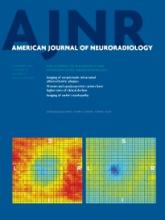Research ArticleBrain
Open Access
Prediction of Pseudoprogression in Patients with Glioblastomas Using the Initial and Final Area Under the Curves Ratio Derived from Dynamic Contrast-Enhanced T1-Weighted Perfusion MR Imaging
C.H. Suh, H.S. Kim, Y.J. Choi, N. Kim and S.J. Kim
American Journal of Neuroradiology December 2013, 34 (12) 2278-2286; DOI: https://doi.org/10.3174/ajnr.A3634
C.H. Suh
aFrom the Department of Radiology, Research Institute of Radiology, Asan Medical Center, University of Ulsan College of Medicine, Seoul, South Korea.
H.S. Kim
aFrom the Department of Radiology, Research Institute of Radiology, Asan Medical Center, University of Ulsan College of Medicine, Seoul, South Korea.
Y.J. Choi
aFrom the Department of Radiology, Research Institute of Radiology, Asan Medical Center, University of Ulsan College of Medicine, Seoul, South Korea.
N. Kim
aFrom the Department of Radiology, Research Institute of Radiology, Asan Medical Center, University of Ulsan College of Medicine, Seoul, South Korea.
S.J. Kim
aFrom the Department of Radiology, Research Institute of Radiology, Asan Medical Center, University of Ulsan College of Medicine, Seoul, South Korea.

REFERENCES
- 1.↵
- Gasparetto EL,
- Pawlak MA,
- Patel SH,
- et al
- 2.↵
- Chamberlain MC
- 3.↵
- 4.↵
- 5.↵
- Nihashi T,
- Dahabreh IJ,
- Terasawa T
- 6.↵
- Roberts C,
- Issa B,
- Stone A,
- et al
- 7.↵
- 8.↵
- Liu G,
- Rugo HS,
- Wilding G,
- et al
- 9.↵
- Pope WB,
- Kim HJ,
- Huo J,
- et al
- 10.↵
- Wen PY,
- Macdonald DR,
- Reardon DA,
- et al
- 11.↵
- Evelhoch JL,
- LoRusso PM,
- He Z,
- et al
- 12.↵
- Tozer DJ,
- Jager HR,
- Danchaivijitr N,
- et al
- 13.↵
- DeLong ER,
- DeLong DM,
- Clarke-Pearson DL
- 14.↵
- Evelhoch JL
- 15.↵
- Narang J,
- Jain R,
- Arbab AS,
- et al
- 16.↵
- Kiselev VG
- 17.↵
- 18.↵
- Walker-Samuel S,
- Leach MO,
- Collins DJ
- 19.↵
- 20.↵
- Levy LM
- 21.↵
- Hu LS,
- Baxter LC,
- Smith KA,
- et al
In this issue
American Journal of Neuroradiology
Vol. 34, Issue 12
1 Dec 2013
Advertisement
C.H. Suh, H.S. Kim, Y.J. Choi, N. Kim, S.J. Kim
Prediction of Pseudoprogression in Patients with Glioblastomas Using the Initial and Final Area Under the Curves Ratio Derived from Dynamic Contrast-Enhanced T1-Weighted Perfusion MR Imaging
American Journal of Neuroradiology Dec 2013, 34 (12) 2278-2286; DOI: 10.3174/ajnr.A3634
0 Responses
Prediction of Pseudoprogression in Patients with Glioblastomas Using the Initial and Final Area Under the Curves Ratio Derived from Dynamic Contrast-Enhanced T1-Weighted Perfusion MR Imaging
C.H. Suh, H.S. Kim, Y.J. Choi, N. Kim, S.J. Kim
American Journal of Neuroradiology Dec 2013, 34 (12) 2278-2286; DOI: 10.3174/ajnr.A3634
Jump to section
Related Articles
- No related articles found.
Cited By...
- Structural and practical identifiability of contrast transport models for DCE-MRI
- Response Assessment in Neuro-Oncology Criteria for Gliomas: Practical Approach Using Conventional and Advanced Techniques
- Detection of Local Recurrence in Patients with Head and Neck Squamous Cell Carcinoma Using Voxel-Based Color Maps of Initial and Final Area under the Curve Values Derived from DCE-MRI
- Quantitative Evaluation for Differentiating Malignant and Benign Thyroid Nodules Using Histogram Analysis of Grayscale Sonograms
- Differentiating Tumor Progression from Pseudoprogression in Patients with Glioblastomas Using Diffusion Tensor Imaging and Dynamic Susceptibility Contrast MRI
- ASFNR Recommendations for Clinical Performance of MR Dynamic Susceptibility Contrast Perfusion Imaging of the Brain
- Diffusion and Perfusion MRI to Differentiate Treatment-Related Changes Including Pseudoprogression from Recurrent Tumors in High-Grade Gliomas with Histopathologic Evidence
This article has been cited by the following articles in journals that are participating in Crossref Cited-by Linking.
- Praneil Patel, Hediyeh Baradaran, Diana Delgado, Gulce Askin, Paul Christos, Apostolos John Tsiouris, Ajay GuptaNeuro-Oncology 2017 19 1
- Bart R. J. van Dijken, Peter Jan van Laar, Gea A. Holtman, Anouk van der HoornEuropean Radiology 2017 27 10
- K. Welker, J. Boxerman, A. Kalnin, T. Kaufmann, M. Shiroishi, M. WintermarkAmerican Journal of Neuroradiology 2015 36 6
- Jeffrey D. Rudie, Andreas M. Rauschecker, R. Nick Bryan, Christos Davatzikos, Suyash MohanRadiology 2019 290 3
- A.J. Prager, N. Martinez, K. Beal, A. Omuro, Z. Zhang, R.J. YoungAmerican Journal of Neuroradiology 2015 36 5
- D.J. Leao, P.G. Craig, L.F. Godoy, C.C. Leite, B. PoliceniAmerican Journal of Neuroradiology 2020 41 1
- S. Wang, M. Martinez-Lage, Y. Sakai, S. Chawla, S.G. Kim, M. Alonso-Basanta, R.A. Lustig, S. Brem, S. Mohan, R.L. Wolf, A. Desai, H. PoptaniAmerican Journal of Neuroradiology 2016 37 1
- Abdul W. Abbasi, Henriette E. Westerlaan, Gea A. Holtman, Kamal M. Aden, Peter Jan van Laar, Anouk van der HoornClinical Neuroradiology 2018 28 3
- Bum-Sup Jang, Seung Hyuck Jeon, Il Han Kim, In Ah KimScientific Reports 2018 8 1
- Ji Eun Park, Ho Sung Kim, Kye Jin Park, Sang Joon Kim, Jeong Hoon Kim, Seth A. SmithRadiology 2016 278 2
More in this TOC Section
Similar Articles
Advertisement











